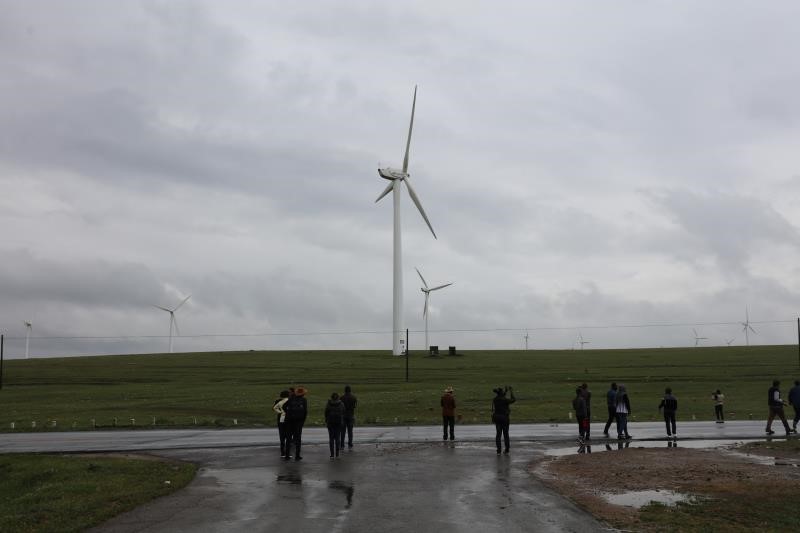

Inner Mongolia Autonomous Region is an important energy base in China. Blessed with abundant coal, wind and solar energy, the growth of its traditional power and clean energy industry has been gaining momentum, thus making the Region one of the front-runners of the nation’s power industry.
In 2016, the output of coal production reached 845.5 million tons. The installed wind power capacity was 25.56 million kilowatts, 17% of the country’s total. The wind power output reached 46.4 billion kwhs. The installed solar power capacity reached 6.36 million tons and the output 8.3 billion kwhs.
China is currently the largest energy consumer in the world and the largest producer and consumer of coal.

Beijing New Energy Cooperation wind power generation
Inner Mongolia thrives in wind energy resources and is close to power grid load centres for North, Northeast and Northwest China. The Autonomous Region has an advantage in land environment protection, power grid construction and installed electric power capacity, which has culminated into a national wind power base.
Beijing New Energy Cooperation has 260mw installed capacity (200 from wild wind and 60 from other sources of automated power).
The wind power generation came into use in the 80s with 600mega kilowatt installed wind power across the world, out of which 150 mega kilowatts is installed in China.
The first stage of wind power was introduced in Denmark from 1986 to 1993, during which period it started in China. During the second stage (1994 – 2002), it was introduced in some provinces with 20 stations built. The third stage (2003 to date) has witnessed rapid increase with laws already established to regulate the wind power sector.
Solar power and wind power are environmental friendly in so much that they can reduce emission. 70% of energy in China is generated from coal burning and 30% from solar and wind energy.
“Let us join hands together and strive forward to usher in a new chapter of social progress in the energy and other sectors to make Inner Mongolia more prosperous,” says Zhang Shouxiao, Deputy Secretary General of the People’s Government of Inner Mongolia Autonomous Region.
China's carbon emissions are estimated to have fallen in recent years, after growing by more than 75 percent in the previous 10 years, and some of the improvements reflect structural influences.

The Kubuqi solar power station
Inner Mongolia can boast of a 200MWp Solar Project. Construction to establish the project was started on November 6, 2015 and it came into service on June 16, 2016. The total investment is 1.6 billion yuan and its annual generating capacity is 350 million KWh with a unit price of 0.9 yuan per KWh. The total area of the project which is built on unutilized desertified land rented from herdsmen is 10 square kilometres.
The project used 250 thousand pieces of pile foundation and contains more than 10 thousand tons of brackets and 650 thousand solar panels whose cost is about 60% of the total project cost (Price of a 310-watt solar panel is 1200 yuan).
The Ecological photovoltaic desertification control is a brand-new method of clean energy desertification control explored and found by Elion Resources in process of desert ecological restoration for 29 years.
Elion developed the integration of desertification control and power generation, amongst other development activities to promote three-dimensional development.
Now the Kubuqi solar power station has combined to the grid.
Inner Mongolia Autonomous Region is situated in the north of China, bordering Mongolia and Russia in the north, and is adjacent to provinces like Jilin and Liaoning in the east, Hebei, Shanxi, Shaanxi provinces and Ningxia Hui Autonomous Region in the south and Gansu province in the west.
It has the biggest grid connection scale in China, and west and east Inner Mongolia power grids have helped accumulate valuable experiences in wind power construction, operation, scheduling, management and technical renovation.
Abu Bakarr Kargbo is a Senior Staff Writer of Standard Times Newspaper in Sierra Leone and an Intern at People’s Daily Online.

 Award-winning photos show poverty reduction achievements in NE China's Jilin province
Award-winning photos show poverty reduction achievements in NE China's Jilin province People dance to greet advent of New Year in Ameiqituo Town, Guizhou
People dance to greet advent of New Year in Ameiqituo Town, Guizhou Fire brigade in Shanghai holds group wedding
Fire brigade in Shanghai holds group wedding Tourists enjoy ice sculptures in Datan Town, north China
Tourists enjoy ice sculptures in Datan Town, north China Sunset scenery of Dayan Pagoda in Xi'an
Sunset scenery of Dayan Pagoda in Xi'an Tourists have fun at scenic spot in Nanlong Town, NW China
Tourists have fun at scenic spot in Nanlong Town, NW China Harbin attracts tourists by making best use of ice in winter
Harbin attracts tourists by making best use of ice in winter In pics: FIS Alpine Ski Women's World Cup Slalom
In pics: FIS Alpine Ski Women's World Cup Slalom Black-necked cranes rest at reservoir in Lhunzhub County, Lhasa
Black-necked cranes rest at reservoir in Lhunzhub County, Lhasa China's FAST telescope will be available to foreign scientists in April
China's FAST telescope will be available to foreign scientists in April